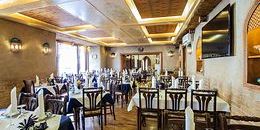Muruzi House
Unusually ornate even by the standards of St. Petersburg's grand apartment buildings, the Muruzi House was built in the Moorish style and decorated so elaborately that it is truly a work of architectural art. Architect Alexey Serebryakov created this building 1874-1876 for Prince Alexander Muruzi, the wealthy scion of a family of Phanariote Greeks prominent in Moldavia. Its style was inspired by the Alhambra in Granada. The facades were decorated with corner towers, bay windows, alcoves, balconies, terracotta columns, arabesques, and Arabic script. The grand staircase was decorated with mirrors, marble statues, and oriental furnishings and carpets.

Equally luxurious were the interiors. An internal staircase made of white Carrara marble led to the second floor to a hall that resembled a Moorish palace courtyard. The hall's arches were built on 24 thin marble columns and a fountain stood in the middle. The house had five grand staircases, water heating, steam laundry, and 28 bathrooms. It was the richest apartment building in Petersburg and many members of the nobility lived here, including Major General Alexander Alexandrovich Pushkin, the poet's eldest son; and the Chamberlain of the Imperial Court Dmitry Lyubimov.
However, the Muruzi House is most famous for its myriad connections to Russian literature. Among the building's earliest tenants, the great satirical writer Nikolay Leskov lodged in a small two-bedroom apartment in 1879. In 1889, the famous literary couple of philosopher and writer Dmitry Merezhkovskiy and poet Zinaida Gippius moved into the building, and they lived here for almost a quarter of a century, counting many other prominent literary figures of the day among their guests. Even before its construction, the site of the Muzuri House, formerly the mansion and garden of Prince Vasiliy Kochubey, which purportedly provided the model for the home of General Yelanchin in Dostoevsky's novel The Idiot.

In 1919, the Prince's apartments became home to the literary studio of the Vsemirnaya Literatura ("World Literature") publishing house. This short-lived educational project, patronized by Maksim Gorky, boasted an extraordinary range of literary talent amongst its teachers and students: The leading acmeist poet Nikolay Gumilev headed the poetry course, while Yevgeny Zamyatin, author of the seminal dystopian novel We taught prose. Gorky also gave lectures, and Alexander Blok readings of his verse. Among the students was the much-loved Leningrad satirist Mikhail Zoshchenko.
The Muruzi House's most celebrated literary connection, however, was as the family home (in one large room, or "room-and-a-half", of a communal apartment) of the Russian-American Nobel laureate Joseph Brodsky. Brodsky's mother and father, a professional interpreter and a naval photographer, moved there in 1949, when was Brodsky was nine years old, and it was his only permanent home right up until he was exiled from the USSR in 1972. Efforts to establish a museum to Brodsky, one of St. Petersburg's best-loved poets, in apartment No. 28 are close to fruition after over a decade of difficulties.
Although the Muruzi House today cannot boast the opulent interiors it once did, its extraordinary facades have been mostly restored to their full glory and are still among the most striking certainly on Liteiny Prospekt and arguably anywhere in St. Petersburg.
| Address: | 24, Liteiny Prospekt |
|---|---|
| Metro stations: | Chernyshevskaya |
| Directions: | Exit Chernishevskaya metro station and turn left then right onto Kirochnaya Ulitsa. Walk to the end of the street and turn left onto Liteiny Prospekt. The Muruzi house is at the corner of the next block. |
| What's nearby? | Liteiny Prospekt, Preobrezhenskaya Ploschad (Transfiguration Square), Ulitsa Pestelya, Transfiguration Cathedral |







